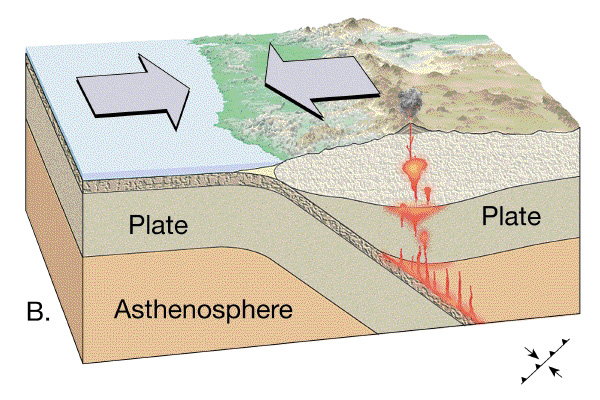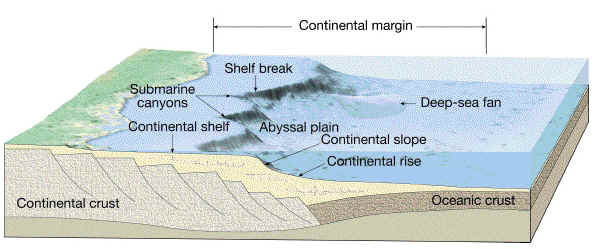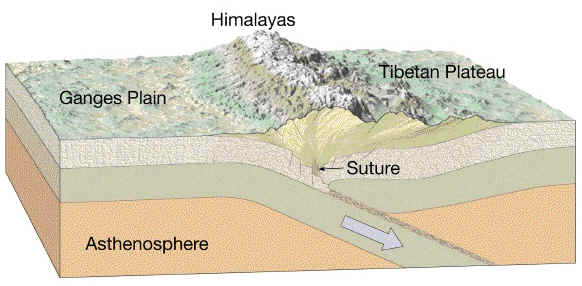
ISOSTATIC UPLIFT.
TECTONICS, OROGENESIS.
29% of the earth's surface is above sea-level - a volume of about 1.3 x 108 km3. About 13.6 km3 is eroded from continents each year; therefore it would take only about 10 million years to completely flatten the land surfaces - but the earth is about 4.6 billion years old. Clearly processes are operating to maintain RELIEF (i.e. uplift to compensate for erosional lowering).
Isostatic uplift offsets some of the erosional lowering (lower density continental crust rises up as weight is removed), but isostasy canít explain the creation of new mountain belts. This process is OROGENESIS - part of the theory of plate tectonics.

ISOSTATIC UPLIFT.

STRUCTURE OF UPPER MANTLE & CRUST.
Continental crust:
averages about 35 km thick. Rich in feldspars and "granitic" rocks.
Oceanic crust:
5-12 km thick. Rich in iron and magnesium - basaltic rock.
Upper mantle:
the uppermost part of the mantle (approx. 100 km) is cooler and rigid, compared
to the deeper mantle. Rich in iron and magnesium - peridotite rock (olivine and
pyroxene minerals). This part of the mantle together with the overlying crust is
the LITHOSPHERE (approx. the upper 100 km of the earth).
The Asthenosphere:
this part of the mantle, between about 100 and 700 km deep, is partially molten
and capable of flowing slowly (especially between 100-200 km).
The lithosphere is not continuous, but is fractured into a number of LITHOSPHERIC PLATES (about 7 major plates). The plates are moving at typical velocities of 1 -10 cm/year (fingernail growth rate).
Orogenesis occurs mainly at convergent boundaries.

CONVERGENT BOUNDARY.
OROGENESIS AT CONVERGENT BOUNDARIES
1. Passive Margins: prior to orogenesis, the continental boundary is a PASSIVE margin. Sedimentation at passive margins reflects the progressive increase in water depth. Nearshore deposits are coarser - sand grading to silt and clay; further out on the continental shelf in clean shallow water, carbonate reefs form in tropical regions. Together these sediments are known as MIOGEOCLINAL DEPOSITS. On the deeper continental slope and rise, mostly fine-grained clastic sediments accumulate, forming SHALES and GREYWACKES. These are EUGEOCLINAL DEPOSITS. A common feature of continental margins undergoing extensive sedimentation is SUBSIDENCE, due to the weight of sediment ISOSTATICALLY DEPRESSING the crust; in this way shallow water deposits (e.g. 100í depth) can build up thicknesses of 1000's of feet.

PASSIVE MARGIN.
Cordilleran-Type Orogenesis
1. Passive stage
(pre-convergence) -> marginal deposits form.
2. early subduction ->
marginal deposits are deformed by compression. Folds and thrust faults are
formed.
3. Volcanic arc forms.
4. Lateral growth by
accretion; emplacement of igneous masses; metamorphism; further deformation of
marginal deposits.
5. Continued uplift and
deformation results from continuing plate convergence.
6. Erosion forms a
sediment wedge in the backarc basin.
Examples = Andes of western south America.

Cordilleran-Type
Orogenesis
Continental Collision-Type Orogenesis
Initial growth is similar to Cordilleran-type orogenesis; however, when the continents collide one of them can not be subducted (too thick and buoyant), therefore the plates are welded together forming a SUTURE ZONE and producing a large mountain chain, containing sedimentary, igneous and metamorphic rock.
The collision that created the Himalayas is the classic example of continent-continent orogenesis. The Himalayas are very high because they are very young (geologically). Uplift continues and erosion hasnít had long to wear the mountains down.

HIMALAYAS.
The suturing of land masses is an example of continental growth by accretion - if a relatively small crustal fragment is accreted to a larger continent, the small addition is known as an EXOTIC TERRANE (meaning it originated elsewhere).
The value of plate tectonic theory is that it has, for the first time, provided a framework within which we can understand the mechanism and relationship of the Earth's major physical features - continents, ocean basins, mountain systems, volcanoes, earthquakes, ocean trenches, mid-ocean ridges, and rock suites. It has been suggested that this unifying concept should be called global tectonics.
Although tectonics can explain a wide range of continental and oceanic features, we will deal only with large-scale continental features which provide a structural framework upon which landforms develop.